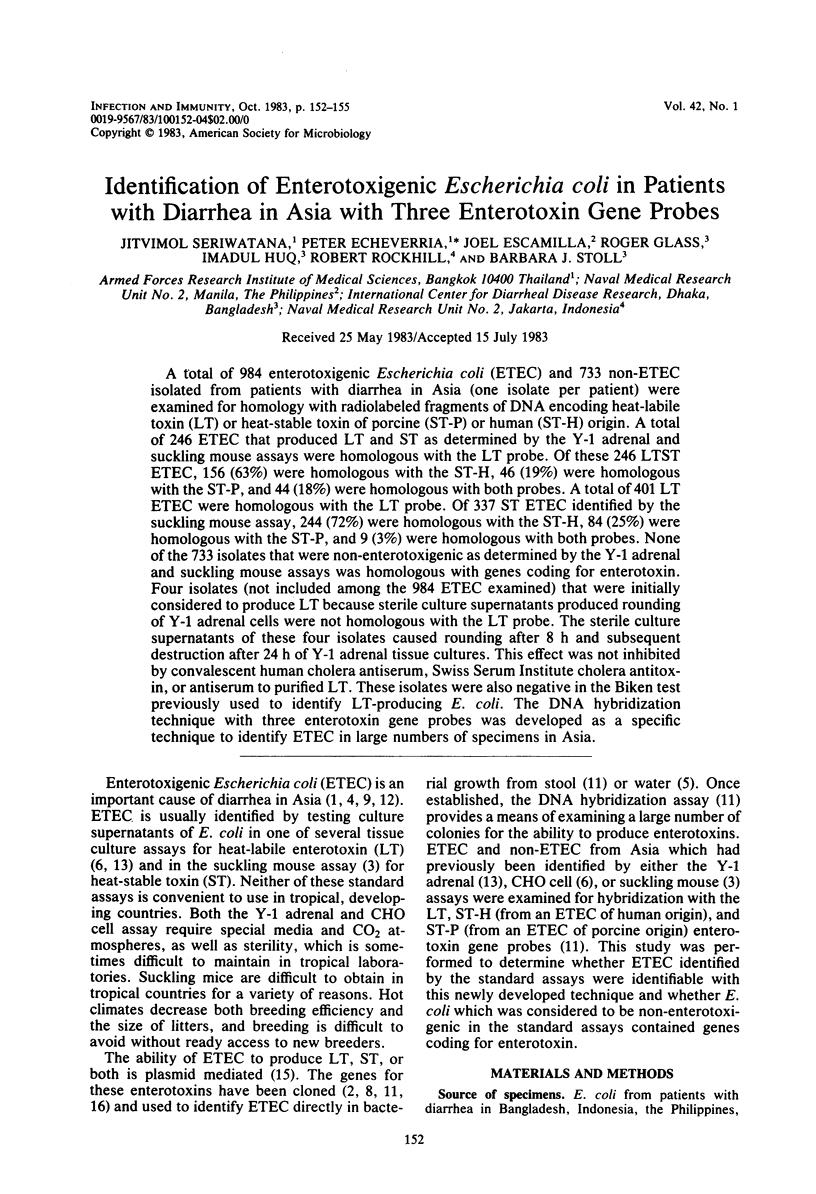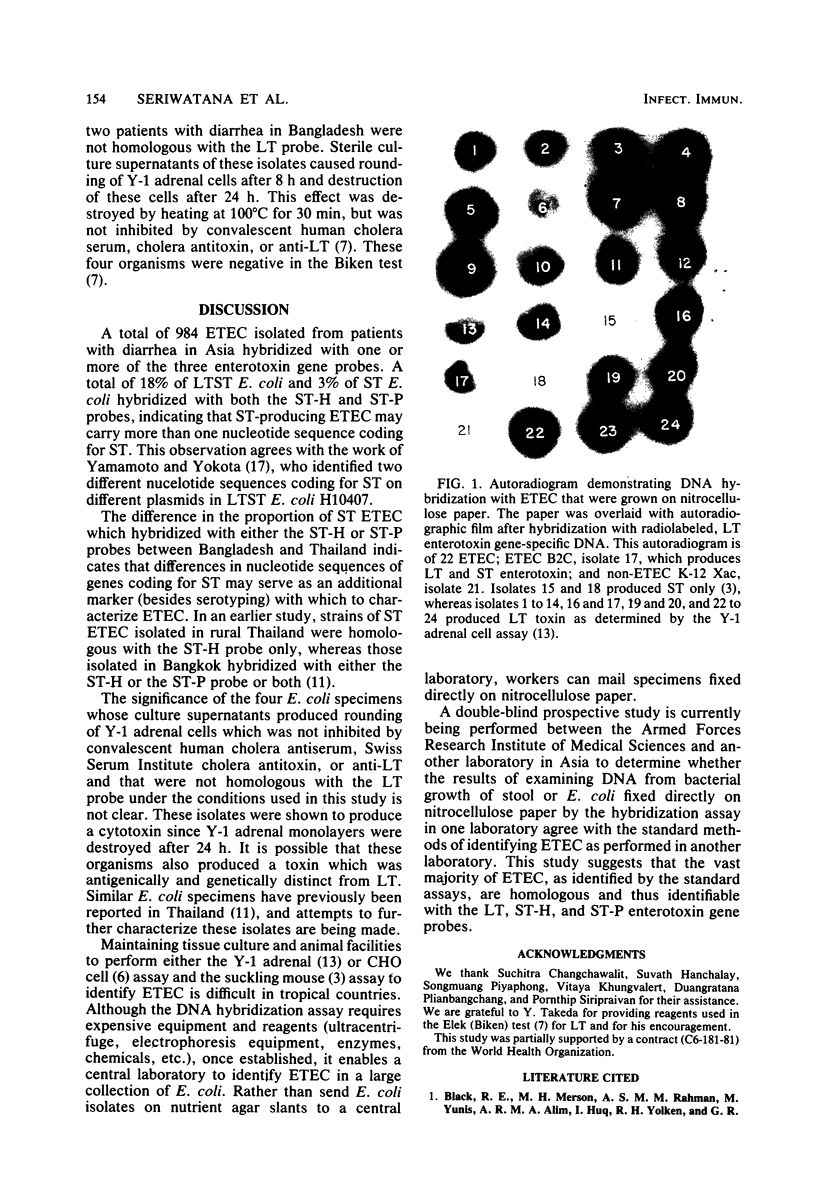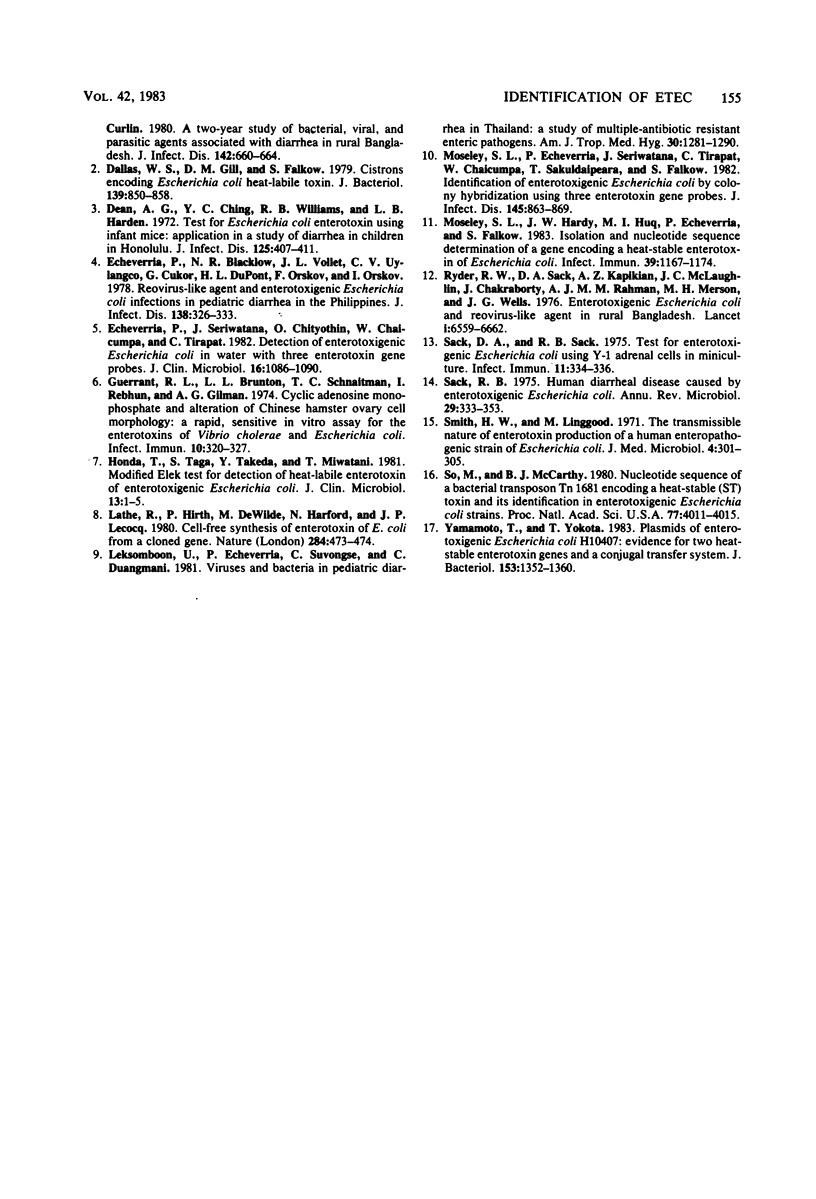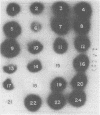Abstract
A total of 984 enterotoxigenic Escherichia coli (ETEC) and 733 non-ETEC isolated from patients with diarrhea in Asia (one isolate per patient) were examined for homology with radiolabeled fragments of DNA encoding heat-labile toxin (LT) or heat-stable toxin of porcine (ST-P) or human (ST-H) origin. A total of 246 ETEC that produced LT and ST as determined by the Y-1 adrenal and suckling mouse assays were homologous with the LT probe. Of these 246 LTST ETEC, 156 (63%) were homologous with the ST-H, 46 (19%) were homologous with the ST-P, and 44 (18%) were homologous with both probes. A total of 401 LT ETEC were homologous with the LT probe. Of 337 ST ETEC identified by the suckling mouse assay, 244 (72%) were homologous with the ST-H, 84 (25%) were homologous with the ST-P, and 9 (3%) were homologous with both probes. None of the 733 isolates that were non-enterotoxigenic as determined by the Y-1 adrenal and suckling mouse assays was homologous with genes coding for enterotoxin. Four isolates (not included among the 984 ETEC examined) that were initially considered to produce LT because sterile culture supernatants produced rounding of Y-1 adrenal cells were not homologous with the LT probe. The sterile culture supernatants of these four isolates caused rounding after 8 h and subsequent destruction after 24 h of Y-1 adrenal tissue cultures. This effect was not inhibited by convalescent human cholera antiserum, Swiss Serum Institute cholera antitoxin, or antiserum to purified LT. These isolates were also negative in the Biken test previously used to identify LT-producing E. coli. The DNA hybridization technique with three enterotoxin gene probes was developed as a specific technique to identify ETEC in large numbers of specimens in Asia.
Full text
PDF



Images in this article
Selected References
These references are in PubMed. This may not be the complete list of references from this article.
- Black R. E., Merson M. H., Rahman A. S., Yunus M., Alim A. R., Huq I., Yolken R. H., Curlin G. T. A two-year study of bacterial, viral, and parasitic agents associated with diarrhea in rural Bangladesh. J Infect Dis. 1980 Nov;142(5):660–664. doi: 10.1093/infdis/142.5.660. [DOI] [PMC free article] [PubMed] [Google Scholar]
- Dallas W. S., Gill D. M., Falkow S. Cistrons encoding Escherichia coli heat-labile toxin. J Bacteriol. 1979 Sep;139(3):850–858. doi: 10.1128/jb.139.3.850-858.1979. [DOI] [PMC free article] [PubMed] [Google Scholar]
- Dean A. G., Ching Y. C., Williams R. G., Harden L. B. Test for Escherichia coli enterotoxin using infant mice: application in a study of diarrhea in children in Honolulu. J Infect Dis. 1972 Apr;125(4):407–411. doi: 10.1093/infdis/125.4.407. [DOI] [PubMed] [Google Scholar]
- Echeverria P., Blacklow N. R., Vollet J. L., 3rd, Ulyangco C. V., Cukor G., Soriano V. B., DuPont H. L., Cross J. H., Orskov F., Orskov I. Reovirus-like agent and enterotoxigenic Escherichia coli infections in pediatric diarrhea in the Philippines. J Infect Dis. 1978 Sep;138(3):326–332. doi: 10.1093/infdis/138.3.326. [DOI] [PubMed] [Google Scholar]
- Echeverria P., Seriwatana J., Chityothin O., Chaicumpa W., Tirapat C. Detection of enterotoxigenic Escherichia coli in water by filter hybridization with three enterotoxin gene probes. J Clin Microbiol. 1982 Dec;16(6):1086–1090. doi: 10.1128/jcm.16.6.1086-1090.1982. [DOI] [PMC free article] [PubMed] [Google Scholar]
- Guerrant R. L., Brunton L. L., Schnaitman T. C., Rebhun L. I., Gilman A. G. Cyclic adenosine monophosphate and alteration of Chinese hamster ovary cell morphology: a rapid, sensitive in vitro assay for the enterotoxins of Vibrio cholerae and Escherichia coli. Infect Immun. 1974 Aug;10(2):320–327. doi: 10.1128/iai.10.2.320-327.1974. [DOI] [PMC free article] [PubMed] [Google Scholar]
- Honda T., Taga S., Takeda Y., Miwatani T. Modified Elek test for detection of heat-labile enterotoxin of enterotoxigenic Escherichia coli. J Clin Microbiol. 1981 Jan;13(1):1–5. doi: 10.1128/jcm.13.1.1-5.1981. [DOI] [PMC free article] [PubMed] [Google Scholar]
- Lathe R., Hirth P., DeWilde M., Harford N., Lecocq J. P. Cell-free synthesis of enterotoxin of E. coli from a cloned gene. Nature. 1980 Apr 3;284(5755):473–474. doi: 10.1038/284473a0. [DOI] [PubMed] [Google Scholar]
- Leksomboon U., Echeverria P., Suvongse C., Duangmani C. Viruses and bacteria in pediatric diarrhea in Thailand: a study of multiple antibiotic-resistant enteric pathogens. Am J Trop Med Hyg. 1981 Nov;30(6):1281–1290. doi: 10.4269/ajtmh.1981.30.1281. [DOI] [PubMed] [Google Scholar]
- Moseley S. L., Echeverria P., Seriwatana J., Tirapat C., Chaicumpa W., Sakuldaipeara T., Falkow S. Identification of enterotoxigenic Escherichia coli by colony hybridization using three enterotoxin gene probes. J Infect Dis. 1982 Jun;145(6):863–869. doi: 10.1093/infdis/145.6.863. [DOI] [PubMed] [Google Scholar]
- Moseley S. L., Hardy J. W., Hug M. I., Echeverria P., Falkow S. Isolation and nucleotide sequence determination of a gene encoding a heat-stable enterotoxin of Escherichia coli. Infect Immun. 1983 Mar;39(3):1167–1174. doi: 10.1128/iai.39.3.1167-1174.1983. [DOI] [PMC free article] [PubMed] [Google Scholar]
- Sack D. A., Sack R. B. Test for enterotoxigenic Escherichia coli using Y-1 adrenal cells in miniculture. Infect Immun. 1975 Feb;11(2):334–336. doi: 10.1128/iai.11.2.334-336.1975. [DOI] [PMC free article] [PubMed] [Google Scholar]
- Sack R. B. Human diarrheal disease caused by enterotoxigenic Escherichia coli. Annu Rev Microbiol. 1975;29:333–353. doi: 10.1146/annurev.mi.29.100175.002001. [DOI] [PubMed] [Google Scholar]
- Smith H. W., Linggood M. A. The transmissible nature of enterotoxin production in a human enteropathogenic strain of Escherichia coli. J Med Microbiol. 1971 Aug;4(3):301–305. doi: 10.1099/00222615-4-3-301. [DOI] [PubMed] [Google Scholar]
- So M., McCarthy B. J. Nucleotide sequence of the bacterial transposon Tn1681 encoding a heat-stable (ST) toxin and its identification in enterotoxigenic Escherichia coli strains. Proc Natl Acad Sci U S A. 1980 Jul;77(7):4011–4015. doi: 10.1073/pnas.77.7.4011. [DOI] [PMC free article] [PubMed] [Google Scholar]
- Yamamoto T., Yokota T. Plasmids of enterotoxigenic Escherichia coli H10407: evidence for two heat-stable enterotoxin genes and a conjugal transfer system. J Bacteriol. 1983 Mar;153(3):1352–1360. doi: 10.1128/jb.153.3.1352-1360.1983. [DOI] [PMC free article] [PubMed] [Google Scholar]



